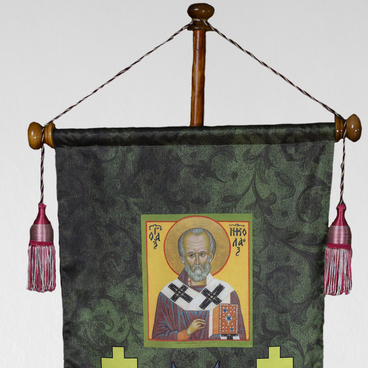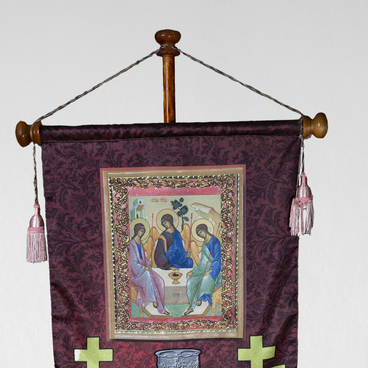The city of Pogar was located at the border territory and therefore influenced by several cultures: Ukrainian, Russian and Belarusian. So it was quite often that the residents used words from other languages in their speech. For example, oil was “oley”, students were “uchni”, “kravtsy” stood for tailors, and blacksmiths were “kovaly”. Shoemakers in Pogar also had a name — they were called “shavtsy”.
After Tsar Alexei Mikhailovich granted the establishment of the Magdeburg Law, a special economic regime, in Pogar, guilds started to appear there.
Each guild formed a socio-religious fraternity of the guild minor landed gentry. Fraternities built churches, schools, and almshouses which attended to sick and elderly people. A fraternity house, built at the guild’s expense, was used for holding meetings and celebrating patronal festivals.
The guild’s distinctive markings called tseshki and khorugv (either a cross with holy images or a large banner on a long pole) were kept in a fraternity house. Banners depicted saints. Brocade or velvet fabric banners were embroidered with gold and decorated with fringes and tassels. Usually, khorugvs had long poles. Especially heavy banners featured fittings to be carried by four people.
The shoemakers’ khorugv depicts the emblem of the guild, a high boot and two ankle shoes, as well as the icon of St. Athanasius, the patron saint of the shoemakers. The year of the guild establishment and the name of the head craftsman Grigory Mogila were embroidered on the banner.
During festive church services, khorugvs were placed near a place for chanters and church choir. Before the start of a Cross Procession, khorugv-bearers put on special wide-sleeved long clothes, then carried banners ahead of the procession. Khorugvs were always carried by their guild’s craftsmen.
The Pogar shoemakers’ guild was part of the Athanasius Church. It was first mentioned in 1690, and the church fraternity house was opened in 1725. The records of 1767 showed that the church was wooden, with a bell tower that had five bells. By this time, the fellow brothers had already built a school and an almshouse for sick and elderly people.
After Tsar Alexei Mikhailovich granted the establishment of the Magdeburg Law, a special economic regime, in Pogar, guilds started to appear there.
Each guild formed a socio-religious fraternity of the guild minor landed gentry. Fraternities built churches, schools, and almshouses which attended to sick and elderly people. A fraternity house, built at the guild’s expense, was used for holding meetings and celebrating patronal festivals.
The guild’s distinctive markings called tseshki and khorugv (either a cross with holy images or a large banner on a long pole) were kept in a fraternity house. Banners depicted saints. Brocade or velvet fabric banners were embroidered with gold and decorated with fringes and tassels. Usually, khorugvs had long poles. Especially heavy banners featured fittings to be carried by four people.
The shoemakers’ khorugv depicts the emblem of the guild, a high boot and two ankle shoes, as well as the icon of St. Athanasius, the patron saint of the shoemakers. The year of the guild establishment and the name of the head craftsman Grigory Mogila were embroidered on the banner.
During festive church services, khorugvs were placed near a place for chanters and church choir. Before the start of a Cross Procession, khorugv-bearers put on special wide-sleeved long clothes, then carried banners ahead of the procession. Khorugvs were always carried by their guild’s craftsmen.
The Pogar shoemakers’ guild was part of the Athanasius Church. It was first mentioned in 1690, and the church fraternity house was opened in 1725. The records of 1767 showed that the church was wooden, with a bell tower that had five bells. By this time, the fellow brothers had already built a school and an almshouse for sick and elderly people.



